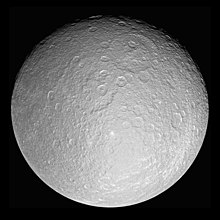റിയ (മൂൺ)
(Rhea (moon) എന്ന താളിൽ നിന്നും തിരിച്ചുവിട്ടതു പ്രകാരം)
റിയ (/ˈriə/ REE-ə; പുരാതന ഗ്രീക്ക്: Ῥέᾱ) (Rhea (moon)) ശനിയുടെ ഏറ്റവും വലിയ രണ്ടാമത്തെ ഉപഗ്രഹവും സൗരയൂഥത്തിലെ ഒൻപതാമത്തെ വലിയ ഉപഗ്രഹവും ആണ്. റിയ ഹൈഡ്രോസ്റ്റാറ്റിക് സന്തുലിതാവസ്ഥയിൽ സ്ഥിതി ചെയ്യുന്ന ഒരു പിണ്ഡമാണ്.[2][3] അതായത് അതിന്റെ സ്വന്തം ഗ്രാവിറ്റിയും അതിലെ പദാർത്ഥങ്ങളുടെ വിതരണം മൂലം അനുഭവപ്പെടുന്ന ആന്തരികബലങ്ങളും പരസ്പരം ക്യാൻസൽ ചെയ്തു പോകുന്നു. തൽഫലമായി ഇതിന്റെ ആകൃതി ക്രമമായി തന്നെ നിലനിൽക്കുന്നു. സൗരയൂഥത്തിൽ ഇത്തരത്തിൽ സന്തുലിതമായി ഇതിനെക്കാളും ചെറുതായി ക്ഷുദ്രഗ്രഹം സിറസ് മാത്രമേ ഉള്ളൂ.[a] 1672-ൽ ജിയോവാനി ഡൊമെനിക്കോ കാസ്സിനി ആണ് ഇതിനെ കണ്ടെത്തിയത്.
 Cassini റിയയുടെ ഒരു മൊസൈക് | |||||||||
| കണ്ടെത്തൽ | |||||||||
|---|---|---|---|---|---|---|---|---|---|
| കണ്ടെത്തിയത് | G. D. Cassini[1] | ||||||||
| കണ്ടെത്തിയ തിയതി | ഡിസംബർ 23, 1672[1] | ||||||||
| വിശേഷണങ്ങൾ | |||||||||
| Saturn V | |||||||||
| Adjectives | Rhean | ||||||||
| ഭ്രമണപഥത്തിന്റെ സവിശേഷതകൾ | |||||||||
| 527108 കി.മീ | |||||||||
| എക്സൻട്രിസിറ്റി | 0.0012583 | ||||||||
| 4.518212 d | |||||||||
Average പരിക്രമണവേഗം | 8.48 km/s | ||||||||
| ചെരിവ് | 0.345° (to Saturn's equator) | ||||||||
| ഉപഗ്രഹങ്ങൾ | Saturn | ||||||||
| ഭൗതിക സവിശേഷതകൾ | |||||||||
| അളവുകൾ | 1532.4 × 1525.6 × 1524.4 km | ||||||||
| 7337000 കി.m2 | |||||||||
| പിണ്ഡം | (2.306518±0.000353)×1021 കി.g (~3.9×10−4 Earths) | ||||||||
ശരാശരി സാന്ദ്രത | 1.236±0.005 g/cm³ | ||||||||
| 0.265 m/s² | |||||||||
| 0.3911±0.0045Anderson, J. D.; Schubert, G. (2007). "Saturn's satellite Rhea is a homogeneous mix of rock and ice". Geophysical Research Letters. 34 (2). Bibcode:2007GeoRL..34.2202A. doi:10.1029/2006GL028100.</ref> (estimate) | |||||||||
| 0.635 km/s | |||||||||
| 4.518212 d (synchronous) | |||||||||
| zero | |||||||||
| അൽബിഡോ | 0.949±0.003 (geometric) | ||||||||
| |||||||||
| 10 | |||||||||
ചിത്രശാല
തിരുത്തുക-
An artist's impression of Rhea's rings
-
Cassini color image of Rhea - large crater Powehiwehi (right center) - chasmata stretch vertically above (past crater Wakonda, near the terminator) - Onokoro Catenae (lower left).
-
Image of the wispy hemisphere, showing ice cliffs - Powehiwehi (upper center); chasmata stretch from upper left to right center - Onokoro Catenae (lower right).
-
View of Rhea's leading hemisphere with crater Inktomi and its prominent ray system just below center; impact basin Tirawa is at upper left
-
Enhanced-color views of Rhea taken by Cassini on 9 February 2015
-
Rhea's horizon viewed on 10 February 2015.
ഇതും കാണുക
തിരുത്തുകകുറിപ്പുകൾ
തിരുത്തുക- ↑ ഒരു പിണ്ഡം ചെറുതാണെങ്കിലും ഹൈഡ്രോസ്റ്റാറ്റിക് സന്തുലിതാവസ്ഥയിൽ സ്ഥിതി ചെയ്യാൻ ബുദ്ധിമുട്ട് കൂടും. ചെറുതാകും തോറും ഗ്രാവിറ്റി കുറയും. അതിനാൽ അതിലെ ഖരവസ്തുക്കൾ സ്വന്തം ആകൃതി നിലനിർത്തും. തൽഫലമായി ഏങ്കോണിച്ച ഒരു ആകൃതി ആയിരിയ്ക്കും ഫലം.
അവലംബം
തിരുത്തുക- ↑ 1.0 1.1 Rhea: Saturn's dirty snowball moon
- ↑ "ആർക്കൈവ് പകർപ്പ്" (PDF). Archived from the original (PDF) on 2011-09-27. Retrieved 2018-06-14.
- ↑ Emily Lakdawalla (12 November 2015). "DPS 2015: First reconnaissance of Ceres by Dawn". The Planetary Society. Retrieved 21 February 2018.
ബാഹ്യ ലിങ്കുകൾ
തിരുത്തുകRhea എന്ന വിഷയവുമായി ബന്ധപ്പെട്ട ചിത്രങ്ങൾ വിക്കിമീഡിയ കോമൺസിലുണ്ട്.
- Rhea Profile at NASA's Solar System Exploration site
- The Planetary Society: Rhea
- Cassini images of Rhea Archived 2011-08-13 at the Wayback Machine.
- Images of Rhea at JPL's Planetary Photojournal
- Movie of Rhea's rotation from the National Oceanic and Atmospheric Administration site
- Rhea global Archived 2021-04-12 at the Wayback Machine. and polar Archived 2021-04-12 at the Wayback Machine. basemaps (March 2012) from Cassini images
- Rhea altlas Archived 2013-04-24 at the Wayback Machine. (released December 2010) from Cassini images
- Rhea nomenclature and Rhea map with feature names from the USGS planetary nomenclature page
- Google Rhea 3D, interactive map of the moon
- Saturn's moon Rhea has thin atmosphere